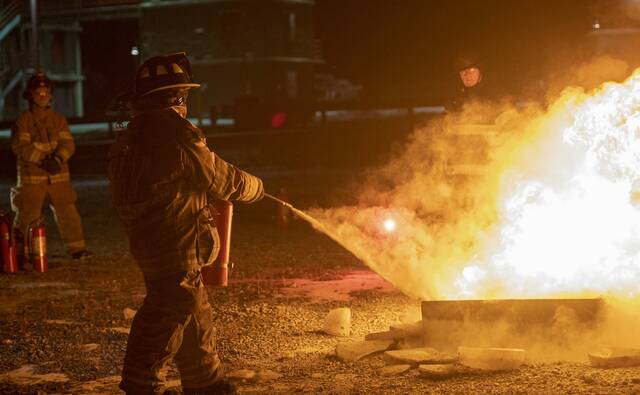College Sports
More local governments in Pa. would be able to tax more to cover fire, EMS costs under new bill
STATE COLLEGE — Hundreds of local governments in Pennsylvania would gain expanded taxing power to fund their cash-strapped fire departments and emergency medical services under a bill advancing in the legislature. Last year, the state legislature gave some local governments the ability to levy higher property taxes to fund fire companies and EMS providers. […]

STATE COLLEGE — Hundreds of local governments in Pennsylvania would gain expanded taxing power to fund their cash-strapped fire departments and emergency medical services under a bill advancing in the legislature.
Last year, the state legislature gave some local governments the ability to levy higher property taxes to fund fire companies and EMS providers. Now, a bill that would expand that opportunity to over 1,400 more municipalities has passed the Democratic-controlled state House.
Local governments in Pennsylvania decide how to fund these emergency services for their communities.
Governing boards can pay for these costs out of their main account, usually called the general fund, or they can set money aside using a special real estate tax and restrict that income to only fire or EMS services.
David Greene, executive director of the Pennsylvania Local Government Commission, a legislative agency, described such a dedicated property tax as a “lock box mechanism.” It “gives the public an understanding that that portion of their tax bill is going [to] and is guaranteed for that specific purpose,” he told Spotlight PA.
But for decades, state law has imposed an upper limit on how much local governments can tax property owners for these purposes: no more than 3 mills for a fire tax, and no more than half a mill for an EMS tax.
These kinds of limits have been criticized by some as arbitrary.
But that changed — to a small extent — last year when state lawmakers approved Act 54, which raised the fire tax limit to 10 mills and the EMS tax cap to 5 mills for about 150 boroughs and townships in Bucks, Delaware, and Montgomery Counties, according to a count compiled by the Pennsylvania Local Government Commission.
In Bucks County’s Northampton Township, the board of supervisors decided it was “absolutely critical” to fund a full-time fire department that is on call every hour of the day, Township Manager Robert Pellegrino told Spotlight PA.
The trouble was that the township was already charging property owners the maximum rate of a fire tax it could under state law: $3 for every $1,000 of the assessed value of a property — or 3 mills. That translates to about $1.8 million, which is less than one-third of the township fire department’s budget, Pellegrino said.
Before the tax cap increase, Northampton Township had limited options to make up the difference. It could transfer money from its general fund, which could put severe strain on other services like police, or it could raise its taxing limits through a voter referendum, which Pellegrino said is an “unsustainable model.”
Pellegrino said his township worked with state legislators on behalf of the measure. Northampton Township was one of the three local governments (all in Bucks County) that have exercised this new, higher taxing authority so far.
“It’s a huge relief and a very big help,” Pellegrino told Spotlight PA. Northampton Township is able to almost entirely fund its fire department with the new tax.
At least 855 of the state’s 2,558 municipalities impose some form of fire tax, according to a database maintained by the Department of Community and Economic Development, which includes tax information submitted by about 80% of local governments. The same dataset showed 224 local governments reported having a tax for ambulance, rescue, and emergency services.
A Spotlight PA analysis of state data found that among municipalities that have a form of fire tax, about 7.5% have reached or exceeded the cap. For those with an EMS tax, 62% have met or gone beyond half a mill.
The increases allowed by Act 54 were “a step in the right direction,” state Rep. Chris Pielli (D., Chester), prime sponsor for House Bill 393, wrote in a memo seeking support from his colleagues. His proposal would allow second-class townships in Pennsylvania — where a majority of commonwealth residents live — the same 10-mill limit for a fire tax and 5-mill cap for an EMS tax.
Pielli, a former township supervisor, told Spotlight PA that his proposal has the support of local fire and EMS agencies. He said that funding is only one aspect of the crisis facing public safety services and that additional actions in Harrisburg, like tax breaks for first responders, should be considered.
“This is a problem that requires a multipronged approach,” Pielli said.
Nearly 90% of the state’s 1,770 registered fire departments are entirely staffed by volunteers, according to the U.S. Fire Administration. A 2021 survey of Pennsylvania’s 744 certified EMS agencies found more than half of them had experienced a budget deficit, according to the Center for Rural Pennsylvania, a legislative agency.
Many local fire companies and EMS providers have sounded the alarm on funding and operational challenges.
“EMS systems are collapsing under the weight of outdated reimbursement models [and] the lack of funding to maintain 24/7 readiness and workforce attrition,” Janette Swade, executive director for the independent Pennsylvania Emergency Health Services Council, told Spotlight PA in an email.
Swade’s organization doesn’t take positions on legislation, including Pielli’s. But she said raising municipal EMS taxes, increasing mutual aid among agencies, and establishing EMS authorities are some solutions the council supports.
David Sanko, executive director of the Pennsylvania State Association of Township Supervisors, told Spotlight PA that the higher taxing limits proposed in Pielli’s bill would enable better local decision-making.
Arden Knapp, chair of the Pleasant Township Board of Supervisors in Warren County, told Spotlight PA the proposed measure is “really necessary.”
Knapp’s rural township now taxes the maximum rates for both fire and EMS services, but revenue continues to be strained, because a third of the township’s land mass is public forest that does not generate tax income.
The township is “taking every bit of that EMS tax” as well as additional monies from the general fund to ensure ambulance services for residents, he said. Part of the cost goes to hiring a private, nighttime ambulance, because staffing has been a struggle.
Knapp said he believes residents will support a potential increase because they realize the financial reality of fire and ambulance services — something Pellegrino, Sanko, and Pielli told Spotlight PA they have observed.
“When you’re dealing with municipalities, I think for the most part, they try to be as responsible as possible and set the rates precisely [as] what they believe is the reasonable amount of revenue that they need,” Greene, of the Local Government Commission, said. The commission tracks which municipalities take advantage of Act 54 and studies the impacts.
Some key questions Greene and his agency will study include why municipalities opt to levy these special real estate taxes, how the increased funding is spent, and whether higher fire and EMS taxes alleviate fundraising pressures. The commission’s assistant director, Kristopher Gazsi, said the study will hopefully inform future bills.
SUPPORT THIS JOURNALISM and help us reinvigorate local news in north-central Pennsylvania at spotlightpa.org/donate. Spotlight PA is funded by foundations and readers like you who are committed to accountability and public-service journalism that gets results.
College Sports
Adrian College Officially Opens the Sweebe Family Indoor Athletic Center as Football Holds First Practice
Story Links ADRIAN, Mich. – Thursday, August 14, 2025, marked a major milestone for Adrian College athletics as the football team held its first official practice inside the new Sweebe Family Indoor Athletic Facility. The brand-new facility, nicknamed “The Dome,” opened its doors to student-athletes as the Bulldogs kicked off the 2025 season. […]

ADRIAN, Mich. – Thursday, August 14, 2025, marked a major milestone for Adrian College athletics as the football team held its first official practice inside the new Sweebe Family Indoor Athletic Facility.
The brand-new facility, nicknamed “The Dome,” opened its doors to student-athletes as the Bulldogs kicked off the 2025 season.
“We are very excited to have the Dome open for our student-athletes,” said Athletic Director Craig Rainey. “This state-of-the-art facility ensures our teams can continue practicing without interruption, regardless of weather. We’re incredibly grateful to the donors who made this possible and look forward to the impact this will have on our athletic success.”
The centerpiece of the facility is a 131,000-square-foot air-supported dome that includes a full-size turf field and a four-lane track. Standing 90 feet tall, the Dome is a striking new landmark visible from across campus.
Attached to the Dome is a 5,000-square-foot lobby featuring two changing rooms, an athletic training room, and an office space to support team operations.
The $11 million facility is designed to serve multiple sports, including football, soccer, rugby, track & field, baseball, softball, and lacrosse. It’s fully equipped with a portable sound system, scoreboards, and shot/play clocks making it suitable for hosting indoor competitions during inclement weather.
The Sweebe Family Indoor Athletic Center is located on the site formerly known as the “Back-40,” nestled between Nicolay Field and the Adrian College Track & Field Complex. In addition to enhancing year-round training opportunities, the project also expands parking options for surrounding athletic venues.
College Sports
Gadowsky picked as head coach for U.S. Collegiate Select Team | News, Sports, Jobs
DAVOS, Switzerland – Penn State’s Guy Gadowsky has been tabbed the head coach for the United States Collegiate Select Team ahead of the 2025 Spengler Cup as announced by College Hockey Inc. earlier Thursday morning. Along with Gadowsky, fellow NCAA bench bosses Mike Souza (UNH) and Jason Lammers (Niagara) will serve as assistants. For the […]

DAVOS, Switzerland – Penn State’s Guy Gadowsky has been tabbed the head coach for the United States Collegiate Select Team ahead of the 2025 Spengler Cup as announced by College Hockey Inc. earlier Thursday morning. Along with Gadowsky, fellow NCAA bench bosses Mike Souza (UNH) and Jason Lammers (Niagara) will serve as assistants.
For the first time in the 102-year history of the tournament, which dates back to 1923 making it the oldest invitational ice hockey tournament in the world, a team of top NCAA collegiate players will compete, led by Gadowsky.
Held annually in Davos, Switzerland from December 26-31, 2025, the Spengler Cup is hosted by the Swiss professional team HC Davos with the 2025 rendition marking the 97th all-time tournament. HC Fribourg-Gotteron defeated the Straubing Tigers, 7-2, in last year’s tournament capturing their first Spengler Cup in the process. The hosts, HC Davos, along with Team Canada have each won 16 Spengler Cups, tying for the most by a single club all-time.
“It’s an honor to be on the inaugural staff of the US Collegiate Selects and to be competing in such a prestigious tournament,” commented Gadowsky. “The Spengler Cup will provide an incredible experience for the players selected and will be great for the continued exposure of college hockey outside of the United States.”
The U.S. Collegiate Select team will be made up of 25 student-athletes, named at a later date, from across NCAA division I men’s ice hockey, with each conference being represented. Along with the Selects, host HC Davos, Team Canada, HC Fribourg-Gotteron, Sparta Praha and IFK Helsinki will be taking part in the 2025 edition, with the six participating teams playing a minimum of two contests.
College Sports
Hockey, prep school and a mystery drive Pittsburgh native’s new novel
Anna Bruno’s second novel, “Fine Young People” (Algonquin), is a whodunit: After one of their classmates dies by suicide, two senior girls at a Sewickley prep school work to unravel the mystery of an earlier, seemingly related death — that of another of the school’s student ice hockey stars two decades earlier. But in addition […]

Anna Bruno’s second novel, “Fine Young People” (Algonquin), is a whodunit: After one of their classmates dies by suicide, two senior girls at a Sewickley prep school work to unravel the mystery of an earlier, seemingly related death — that of another of the school’s student ice hockey stars two decades earlier.
But in addition to being a page-turner, “Fine Young People” is also a critique of the culture of money, ambition and, yes, even sports obsession that enfolds most everyone in the orbit of the fictional St. Ignatius high school.
‘Secular gods’
Bruno grew up in Upper St. Clair and got her own high school diploma from Shady Side Academy. She also grew up Catholic, and she said the social criticism in “Fine Young People” targets the way worldly idols have taken the place of spiritual values.

The nominally Catholic St. Ignatius, she said, “has come to worship secular gods like the endowment and the hockey team and Ivy League admissions.”
The book’s protagonist, Frankie Northrup, is a high achiever with a single mom who tackles the closed-case murder mystery as a class project with her best friend, Shivani. St. Ignatius hockey legend Woolf Whiting, it’s said, was bound for the NHL; his death, too, was ruled a suicide, but the girls don’t buy it, and their sleuthing touches on everything from schoolboy athletes on painkillers to family politics and shady business deals.
The book toggles between third-person accounts of past events and Frankie’s own soul-searching but witty present-day narration. The high school senior, specially tuned to differences in social class, characterizes her sort-of boyfriend thus: “Ingo squinted at me with the earnest cluelessness of a boy who’d never had to make his own sandwich.”
But it’s perhaps ice hockey, complete with hometown references to the Pittsburgh Penguins, that the story revolves around most. “Everyone in a way loses [themselves] in this sport, which they care so much about,” Bruno said. “The book is questioning, ‘Well, why do we care so much about it? Or why do we care so much about it that we’re willing to give up everything else for it?’”
‘A soulless place’
Bruno played soccer in high school (her brother was the hockey player), and her writing draws on her campus experiences. She set the novel in Sewickley rather than Fox Chapel — home to Shady Side — because it offers a business district in which characters can convene.
And like her young characters — one of whom is an 18-year-old who has apparently begun planning for retirement — Bruno was an ambitious kid. She graduated from Stanford University and worked in PR and marketing for tech and financial-services companies in Silicon Valley.
“So I was living in California for about 10 years and I thought that was what I was supposed to be doing, and I was supposed to be making money and being successful as sort of classically defined,” she said. She even earned an MBA from Cornell.
Not surprisingly, she enjoyed spending her 20s in San Francisco. But something, as they say, was missing. A lot, actually.
“I think Silicon Valley is a bit of a soulless place,” Bruno said. “That sounds harsh coming out of my mouth right now, but there is such a focus there on the tech industry and venture capital and just extreme wealth and a lot of the other stuff that makes a life, whether it’s the arts or other parts of the culture, … sort of get pushed to the side.”
“I realized that I wanted to be a writer,” she said. “That I was more interested in the spiritual — my inner life, I guess my ambitions were directed more towards that.”
Bruno has now spent 10 years in Iowa City, where she earned an MFA in Fiction from the Iowa Writers’ Workshop. She lives with her husband and two sons and teaches at the University of Iowa’s Tippie College of Business and the Iowa Summer Writing Festival.
Her choice seems to be paying off. Like her debut novel, 2020’s “Ordinary Hazards,” “Fine Young People” is drawing strong reviews.
“Bruno uses the framework of a whodunit to drive at deeper questions of faith and family,” wrote Publisher’s Weekly. “Bruno pulls it off, thanks to her keen sense of what’s at stake for her teenage characters and Frankie’s indelible voice. It’s a winner.”
College Sports
New details on how MLB might split expiring ESPN package
The saga of ESPN’s expiring MLB rights package involves four contenders — and perhaps more — vying for different pieces of the pie. MLB is in active negotiations with ESPN, Comcast-owned NBCUniversal, Apple and Netflix on the expiring ESPN rights package, and it is possible that other platforms could enter the mix, Andrew Marchand of […]

The saga of ESPN’s expiring MLB rights package involves four contenders — and perhaps more — vying for different pieces of the pie.
MLB is in active negotiations with ESPN, Comcast-owned NBCUniversal, Apple and Netflix on the expiring ESPN rights package, and it is possible that other platforms could enter the mix, Andrew Marchand of The Athletic reported Thursday. Though Marchand did not state as much, the details of the report leave open the possibility that MLB could reach deals with all four companies.
The expiring $550 million/year package, which includes “Sunday Night Baseball,” the Wild Card round, Home Run Derby and a handful of weekday games (including Opening Day), has been on the market since ESPN opted out of the final three years of its deal in February. Any deals MLB eventually reaches will be for those remaining seasons only, bringing the expiration in line with those of the league’s deals with Fox and TNT Sports.
According to Marchand, Apple and NBCUniversal are believed to be “the final contenders” for “Sunday Night Baseball” and the Wild Card round. Netflix, as reported by Bloomberg last week, is eyeing the Home Run Derby. While the loss of those three properties would seem to leave incumbent ESPN with nothing, Marchand reported Thursday that ESPN is “after a new set of rights” that would include weekday and local games.
ESPN president Jimmy Pitaro has repeatedly stated his network’s interest in local MLB rights, including in a podcast interview with Bryan Curtis of The Ringer three days ago. According to Marchand, ESPN is interested in MLB.tv, which the league was reported earlier this year to be willing to include in negotiations.
Depending on the size of a potential weekday package, ESPN could for all intents and purposes exit the national MLB business. “Sunday Night Baseball” has for nearly 40 years been a cornerstone of the network’s lineup and this season is averaging its largest audience since 2017. A move to NBCU would create a year-round run of Sunday night programming with “Sunday Night Football” in the fall, “Sunday Night Basketball” in the spring and “Sunday Night Baseball” in the summer.
For Apple, the acquisition of “Sunday Night Baseball” would presumably give the streamer two weekend nights of exclusive game inventory to go along with the company’s Friday night games.
According to Marchand, it is possible that MLB could split Sunday Night Baseball and the Wild Card games. In that scenario, one imagines NBC would get the Sunday night games; it would defy logic for NBC to acquire the three-day Wild Card round with no other MLB inventory. An Apple package that includes Friday night games and the Wild Card round also seems more in line with the streamer’s strategy than one that includes three games and two nights a week all season long.
In the event that MLB sells Sunday Night Baseball to NBCU, the Wild Card playoffs to Apple, the Home Run Derby to Netflix, and a new package of weeknight and local games to ESPN, the league would seem to have at least some chance of cobbling together a combined rights fee that approaches what ESPN is currently paying.
It would also give the league a whopping seven national rights partners entering the expiration of its media rights deals in 2028.
College Sports
MacBean, Herr earn college soccer honors
LONG BEACH, Calif. – The Penn State women’s soccer program garnered a wide array of national attention from TopDrawerSoccer.com in its preseason releases, with the Nittany Lions landing the No. 6 overall team ranking while securing one Best XI Team selection and a pair of preseason top-100 players in the organization’s releases Tuesday. Penn State […]



LONG BEACH, Calif. – The Penn State women’s soccer program garnered a wide array of national attention from TopDrawerSoccer.com in its preseason releases, with the Nittany Lions landing the No. 6 overall team ranking while securing one Best XI Team selection and a pair of preseason top-100 players in the organization’s releases Tuesday.
Penn State picked up the No. 6 national ranking according to TopDrawerSoccer’s preseason release, the highest rated program in the Big Ten Conference and the highest ranked team in the nation outside of the Atlantic Coast Conference. The Nittany Lions are one of eight Big Ten programs in the national preseason top 25, with PSU joining UCLA (No. 8), Ohio State (No. 9), Michigan State (No. 11), Wisconsin (No. 13), Minnesota (No. 14), Iowa (No. 17) and USC (No. 21). In total PSU, will challenge a trio of teams who are ranked in the national preseason top 25 by the organization, including Duke (No. 5), Ohio State and Wisconsin.
On an individual basis, graduate forward Kaitlyn MacBean secured a pair of preseason accolades, earning an appearance on the TopDrawerSoccer Preseason Best XI Second Team, the only forward from the Big Ten Conference recognized by the TDS Best XI teams. MacBean also secured the second-highest ranking of any B1G athlete in the organization’s Preseason Top 100 Player Rankings, landing the No. 18 position nationally. On the back line, redshirt junior defender Kayleigh Herr picked up the No. 80 individual ranking to round out PSU’s list of preseason accolades from TopDrawerSoccer.
MacBean, a native of Excelsior, Minnesota, published a 2024 season in the Blue & White that was by far her most statistically significant since joining the Penn State program as a true freshman in 2020. Her single-season career-best 34-point outburst a year ago marked the highest scoring individual season by a Nittany Lion since Maya Hayes turned in an astounding 70-point campaign in 2013. MacBean also managed to muster the third-longest goal scoring streak in Penn State history in a span from the 2023 and 2024 seasons. The veteran attacking player started all 25 fixtures for PSU in the team’s run to the NCAA Tournament National Quarterfinals last season, helping anchor the Nittany Lions with the third-most points in the B1G and 15th-most nationally while scoring 16 goals and adding two assists. MacBean was the highest-ranked forward in the league according to TDS and picked up the second-highest overall ranking in the Big Ten behind Ohio State midfielder Amanda Schlueter.
Herr, a native of Cary, North Carolina, made an instant impact on the Nittany Lion back line as an everyday starter in her first season in Happy Valley in 2024. She shattered career highs in multiple statistics, highlighted by a career-best 25 appearances paired with 25 starts in her inaugural season with the Blue & White. Herr finished second on the Penn State roster and was one of just three PSU student-athletes to surpass the 2,000-minute threshold, with the then-redshirt sophomore tallying 2,076 minutes of action on the pitch. She logged one assist and point on the offensive end of the pitch, adding five total shots with three on-target attempts. Overall, Herr helped power the Nittany Lion defense to 11 shutouts in the 2024 season with a 0.88 goals-against average, one of the strongest marks in the nation.
Last season, the Nittany Lions advanced to the National Quarterfinals for the second year in a row, extended the nation’s longest streak of consecutive Sweet 16 appearances to eight-straight, secured the program’s 30th consecutive NCAA Tournament bid and booked the program’s 31st consecutive season with at least 10 victories, the second-longest stretch of that nature in women’s college soccer. The Blue & White return six starters from last year’s Elite Eight run, including goalkeeper Mackenzie Gress, defenders Herr and Bella Ayscue, midfielder Molly Martin, and forwards MacBean and Amelia White. Penn State additionally boasts the nation’s fifth-ranked recruiting class and strongest signing group in the Big Ten Conference per TopDrawerSoccer’s July release. With MacBean and Herr leading the charge, the United Soccer Coaches 11th-ranked Nittany Lions will open their 2025 season in two days’ time, with a 7 p.m. (ET) kickoff scheduled against the fourth-ranked Duke Blue Devils on Thursday, August 14, from Koskinen Stadium in Durham, North Carolina.
College Sports
Lindsey Phibbs ’02 (2025) – Skidmore College Athletics Hall of Fame
Lindsey Phibbs was a once-in-a-generation equestrian talent whose poise, precision, and grace were instrumental in propelling the women’s riding team to national prominence. As captain in her sophomore year, she led her team to national team championships in both the Open Fences and Open Flat divisions. In the same season, she captured the coveted Cacchione […]

Lindsey Phibbs was a once-in-a-generation equestrian talent whose poise, precision, and grace were instrumental in propelling the women’s riding team to national prominence.
As captain in her sophomore year, she led her team to national team championships in both the Open Fences and Open Flat divisions. In the same season, she captured the coveted Cacchione Cup, the highest honor for extraordinary individual performance. The 1999 riding team was inducted into the Hall of Fame in 2008.
Phibbs was celebrated not only for her results but also for her quiet determination and leadership. She was known for having a tremendous feel for the horse and a remarkable eye from the moment she stepped into the ring — instincts that elevated her to the top tier of collegiate riders.
Phibbs was already a rising star in the equestrian world before she came to Skidmore College. In 1997, she was named National Junior Equestrian of the Year by the US Equestrian Federation. She was also the national junior jumper champion and winner of the Washington International Horse Show Equitation Finals.
After Skidmore, Phibbs pursued a career in medicine, becoming a respected OB/GYN in Toledo, Ohio. She brought the same care, precision, and compassion to her patients that she had shown as a rider and teammate.
Lindsey Phibbs passed away in 2015 after a courageous battle with cancer. She is remembered as an extraordinary athlete and dedicated physician who was deeply loved by her family, friends, and teammates. Her legacy endures in the many lives she touched and inspired.
-

 Technology3 weeks ago
Technology3 weeks agoAlly Runs New Game Plan in WNBA All-Star Rookie Debut
-

 Health2 weeks ago
Health2 weeks agoThe Women Driving A New Era In U.S. Ski & Snowboard
-

 NIL2 weeks ago
NIL2 weeks agoESPN Announces 'dont wait run fast' by mgk as New College Football Anthem for 2025
-

 College Sports3 weeks ago
College Sports3 weeks agoCity rows to sporting destination goal on boats of new complexes & old strengths
-

 Sports3 weeks ago
Sports3 weeks agoNtekpere honored as Second Team Academic All-American | APG State News
-

 Rec Sports1 week ago
Rec Sports1 week agoSwimming & Diving Comments on the Rules – 2025-26
-

 Technology1 week ago
Technology1 week agoAmid Sports Chaos, ‘Known’ Data and Outcomes Help Agency Win
-

 College Sports2 weeks ago
College Sports2 weeks agoRep. Pugh: The Red Sand Project brings awareness to ‘very serious issue’
-

 Rec Sports1 week ago
Rec Sports1 week agoSternberg named new youth center director | News, Sports, Jobs
-

 Fashion3 weeks ago
Fashion3 weeks agoWhere to watch Chile vs. Paraguay today































